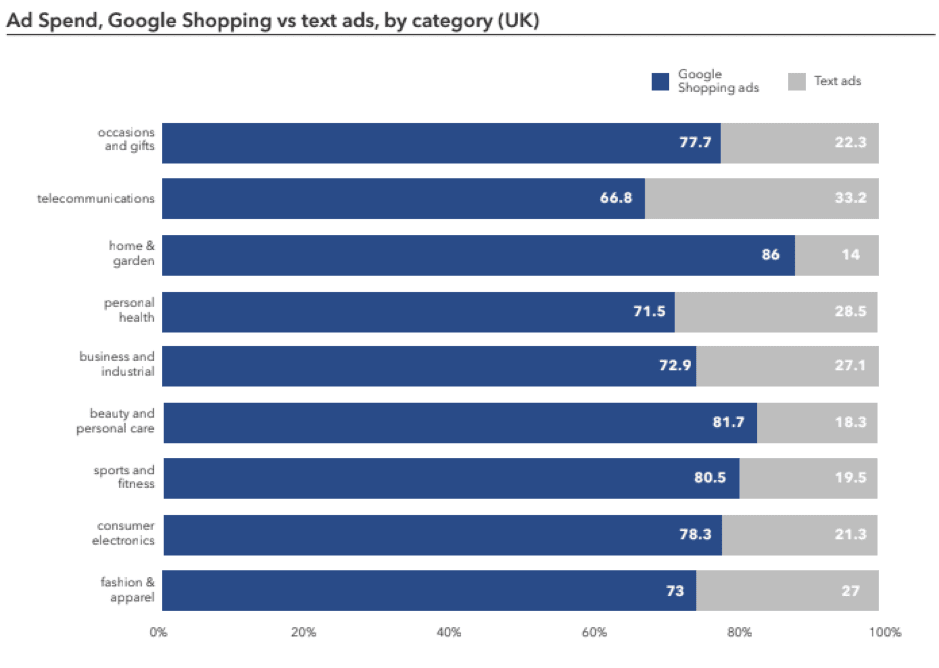Mind Blowing Google Search and Google Shopping Ad Numbers To Conjure With
Depending upon whose analysis you read, the average internet user is exposed to 4,000-10,000 ads every day. But let’s not start to reality check that in our heads going by adverts we have already seen today… Let’s just agree that depending upon your particular lifestyle, when you do start to pay attention to this reality, the scale of marketing exposure can feel bewildering. Reviewing numbers that explain the ubiquity of Google Ads alone is pretty mind-blowing. Let’s show you what we mean and what that means for advertising with Google in 2022.
Work The Numbers With Google Ads
‘Think With Google’ quantified global consumer searches in 2019, via IPSOS, finding: 98% of 14,206 global consumers aged 18+ across 27 countries, (excluding China), pre-pandemic, confirming that they shopped online recently. Countries researched included: Australia, Canada, France, Germany, Italy, Portugal, Spain, GB, U.SA… Bear in mind that post pandemic, ’once in the last week’ is already a huge under-estimate as older generations gained confidence with online shopping, out of necessity.
As 98% of us shopping online isn’t enough, TechJury offer more recent insights, that could push your online success to unprecedented heights in 2022, when setting up Google display ads effectively. They found that SME’s invest between $9K and $10K every month on Google Ads, because this marketing investment pays off. Indeed businesses can no longer afford not to adopt search and shopping ad investments any longer, not only because most, if not all, of their competitors are out there, but also because Google advertisers can expect a 200% return on search and shopping display ad investment
The Case for Google ad investment is strong…
- While SEO is key to generation of leads, investing in PPC doubles your website visitors.
- For increasing reach, Google ads can bring 80% more familiarity with your brand.
- 93% of Americans search online to find local businesses.
No wonder then, that according to Statista, “In 2021, Google’s ad revenue amounted to 209.49 billion U.S. dollars”. The Google Ads platform is the go-to for advertisers seeking significant impacts; Search and Shopping options allow companies to deploy lucrative display ads across Google’s vast search and ad display network of over 2 million partner websites and apps. Implemented correctly, PPC is a powerful marketing tool, not least because Google Ads cover all display ad channels, including YouTube…
Google proudly proclaim they are “the leading PPC player”, owning 92% of the search engine market, including both paid and organic search. Display campaigns alone reach over 90% of all internet users around the world, 94% of these being US-based, say Statista.
Are Customers Still Convinced?
Yes! Customers respond well to retargeting, in particular, being up to 70% more likely to buy products when businesses implement this advertising technique. Retargeting Ads can boost your conversion rates to over 40%, according to some market commentators; 90% of those surveyed on this confirm that ads in general influence purchasing decisions.
We are confident of Google’s continued display ad dominance so much, that we predict 55%+ of ad expenditure will be invested online, in 2022, because Google’s metrics make ROI results measurable and even predictable within small margins for error.
Customers are 155% more likely to search for brand-specific terms when exposed to display ads, according to SERPWatch. While, Google generally delivers 3.46% conversion rates, as a portion of investment, these seemingly modest sums stack up! Advertising with Google still delivers a 200-400% revenue increase; so if you aren’t developing your Google search or shopping strategy, it’s way past time.
U.S. digital ad spend grew by 1.7% in 2020, according to Statista; perhaps locked-down citizens everywhere spent more on their homes, gardens and more, given savings made on not commuting.
Your ranking is highly important to customers, given 40% of all clicks on the first search engine results page happen for the top three top ranking ads, according to 2021 Pay Per Click statistics, so preparation to increase your odds is essential.

We can see from Adthena’s analysis that Google Shopping Ad spend ranged between 64.4% and 86% in the U.S., with U.K. sector profiles looking similar, except that “…within home and garden, beauty and personal care, and personal health is even higher than in the U.S.”
Ad Formats Move On
In 2018, Adthena’s ‘The Rise of Google Shopping’, Adthena Search Advertising Report, Q1, 2018 showed how Google Shopping ads, (or Product Listing Ads / PLAs), “…have become the most popular ad format for retail advertising deployment…”. Ad spend versus previous text ad spend for retailers speak volumes – if you will pardon the pun: “Across US online retail, Google Shopping Ads now make up 76.4% of retail search ad spend, and win 85.3% of all clicks…” on Google Shopping campaigns, or Adwords. This is a landmark PLA spend moment for the U.S. and U.K.. Statistics were compiled from across 40 million ads, 267,000 competitors and looked at a staggering 1 million plus search terms; sectors included fashion, apparel, consumer electronics and home and garden.
Ashley Fletcher, VP Marketing at Adthena noted consumers’ changing responsiveness to evolving ad format trends. “As retailers move ad spend into Google Shopping or mobile campaigns, the retailers who master the nuances of specific categories will be the ones who shape consumer’s ad experiences.” The subtle take-away here is that advertisers need to remain flexible and adapt to how shoppers themselves will shape strategies to suit their needs.
Compare Google Shopping Ads dominance against, 23.6% of retailer spend on text ads, generating 14.7% of clicks; while still a fairly high number, bear in mind that online shopping has mushroomed during the pandemic, so that shift away from traditional formats to more sophisticated advertising for more savvy online shoppers.
Back in Q1 2018, UK, retail advertising Google Shopping Ads spend was around 82%, bringing 87.9% of consumer clicks; 18% text ad spend attracted 12.1% of clicks So, if you are still spending on text ads, it’s time to shift with consumer trends. For some clues on how your business fits into the wider retail picture, here’s how Adthena’s report broke down the categories.
SEO or PPC for 2022 Marketing Investment?
Of course, this is a false dilemma; your business needs both. Sure, ad clicks can get costly quickly, but returns make your investment worth it. PPC offers faster brand awareness and sales results too. Consistent SEO building simultaneously increases visitors cumulatively, despite QuickSprout’s claim that this generates half the visits of paid ads.
SEO investment is a necessary marketing mix ingredient. According to One PPC, the average marketing agency charges between £2K and £4K (around $2.55K-$5.11K) per month for a ‘mid-level SEO’ campaign; this tends to be affordable, if slower in generating sales volume. Expect single booster SEO campaigns to cost anywhere between £4,000 and £24,000, depending upon niche and scope. One-off projects, or on-going management boost your marketing budget.
SearchEngineLand claim that the average yearly B2B Pay Per Click campaign costs between $115K-$122K. Those figures can be off-putting, so if you are looking to develop in-house skills, PPC wins, taking around 3 weeks to master, e.g. low CPC versus high CTR, say BetterSEO. Broader SEO learning can take months… However, whereas visits drop off when ads stop displaying, organic SEO continues to build website visitors…
SEO is also less labour intensive, leaving time to focus on other marketing activities between SEO enhancements; paid ads, however, take consistent monitoring.
TechJury SEO statistics show that 82% of SEO input increases results over time because 94% of users skip Google ads to browse organic content, claim RankPay. SearchEngineLand tell us that there is also differing visibility. Whereas SEO improves visibility via 2-3 search engines, display ads are ubiquitous. So, strategy really does depend on business objectives and other variables, (budget, placement, ad category).
So, in short both strategies offer benefits to business development.
What Is Your Competition Doing?
Some marketing professionals are nervous of blowing budgets too quickly with paid ads. One research source suggests only 17.96% of marketers deploy search ads, but the jury is out on how valid that figure is. We think that sounds too low.
Up to 88% of marketers have been estimated as increasingly choose social media advertising. Of these, apparently 89% favour remarketing for reaching targeted customers. Nevertheless, search ads remain a strong option for faster, measurable results.
Whatever your industry, more businesses are increasing Google search and shopping ad strategies. SearchMarketing claim that 62% of marketers increased their PPC budgets in 2021, aware that every $1 returns at least $2.00. 84% of companies they surveyed are happy with display ad results. 79% of marketers regard this medium as essential. Many interviewees affirmed that their ads budget became “much bigger”, for having invested in Pay Per Click appropriately.
Forbes has claimed that online ads deliver over half of global advertising revenues, with further growth expected in 2022, especially given pandemic constraints being lifted.
Data Drives Retailer Competitiveness in Google Shopping in 2022
On reaching today’s shopper, Google tell retailers that they should not be addressing the challenge of how to: “incorporate deep, timely data into daily planning activities.” They cite Walmart’s effectiveness in maximising product inventory to satisfy customer’s questions online. Matt Kennedy, their senior director of digital marketing says:
“To meet growing consumer demands, we need to leverage the full capacity of our product catalog and the underlying product attributes…”
He adds that this has been possible by using Google insights to clarify how demand is driven, “…across myriad product life cycle stages, allowing us to make better real-time operational decisions.”
Sorting product and service details, at a granular level makes retailer ads much more competitive, by demonstrating relevance when a consumer shows intention to purchase, based on matched criteria following customer searches.
Advertising in 2022 Still Means Google
Adthena offer three key recommendations for developing your Google Ads and Shopping strategy to align with consumers’ evolving ad responses. Firstly, always check out your competitors; obvious, right? We agree that looking at key word categories your competitors are not showing up for offer opportunities for your Google Shopping campaign success.
Secondly, we agree, in regard to machine learning for ads innovations, there are ways to leverage Google’s huge data bank, but AdsRunner recommend techniques for benefiting from this without losing control of your ad spend. Obviously, recommendation #3 is to continually optimize your Google Ad campaigns, to gain marketing budget efficiencies. Review your metrics, respond with ad enhancements, renew content according to what works and repeat.
According to Merkle’s 2019 report, “Google Shopping spending growth has remained robust at 41% year on year”; that’s a strong investment growth rate and a vote of confidence by businesses. Clearly, Google Shopping is proving profitable for more businesses, albeit search is perhaps getting harder to make work for businesses seeking a strong return on ad spend (ROAS). It will be interesting to watch Google search ad investment in 2022, versus the rise of social media advertising, but we can absolutely say for certain, that both Search and Shopping ad profits are undeniably strong and increasing ad investors are testament to the power of display advertising with the behemoth that is Google.
Of course, Google doesn’t share its search volume data, because this is how they maintain control of the online advertising world; advertisers must pay for their insights. However, it’s estimated Google processes a mind-boggling approximately 63,000 search queries every second, translating to 5.5 billion searches per day and approximately 2 trillion global searches per year.. And even as we share this latest data with you, no doubt it is already the lower than Google’s unstoppable growth in display ad domination.
- Written by: Sam Nouri
- Posted on: March 5, 2022
- Tags: Google Ads


